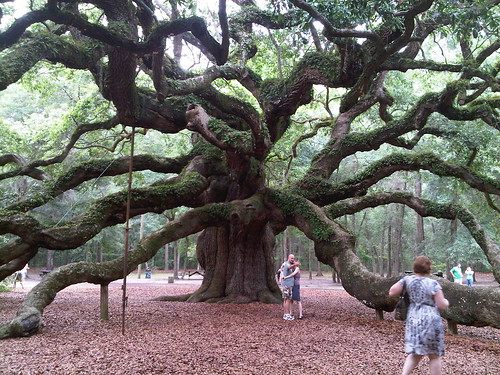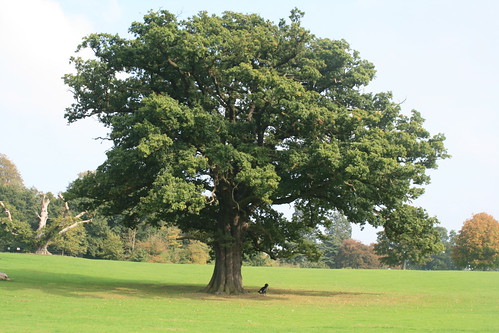
English Oak Tree – Root and Branch Review
Oak trees conjure up images of Robin Hood and mystical Oak forests. Britain has made good use of Oak trees down the centuries. ‘From little acorns great Oak trees grow’
Key Features of the English Oak
- Latin name Quercus robur, other common names include Pendulate or Common Oak
- Height 40m – 130 feet and can have a significant width and root spread
- Type of tree – Most Oaks are deciduous, dictoyledons.
- Leaves are green with irregular deep lobes. The shape of the leaf is atypical oak.
- Flowers are on short stems and inconspicuous on the female and drooping catkins on the male. Both appear on the same tree.
- Fruit is called an acorn and is an ovoid nut one third of which is held in a half enclosed cup.
- Bark is pale grey with deep ridges.
- Family Quercus
Origins and Distribution of the Oak
- English Oak is widely distributed throughout Europe.
- The tree features in Norse and Greek myth and was worshiped by Druids.
Uses and Commercial Attributes of the Oak
- Mature Oaks play an important part in a forests eco-system. They provide food with the abundant supply of acorns and shelter for birds insects and squirrels.
- The bark has a high tannin content and has been used for tanning leather for many centuries.
- The timber has long been prized and built many of the ships upon which Britain built it’s seafaring prominence
- Oak was also used in house building to provide long strong timbers that are still visible today in many tithe barns and old properties.
- Smoked fish and meat is cured over Oak chippings to provide tasty oak smoked products.
- Oaks are often planted in memoriam or to commemorate historic events.
Gardeners Tips for the Oak
- Oaks are large trees and unsuitable for normal sized gardens. After about 8-10 years they are too large and can live 300+ years so they are not even beyond infancy before they bare too big.
- Children love to germinate the acorns and it is quite easy. If you subsequently wish to plant the seedling in the wild ensure it is in a suitable environment like a mixed woodland, with appropriate permission.
Other Types of Oak and Species
- The genus Quercus is currently divided into two subgenera, Quercus and Cyclobalanopsis.
- Quercus ilex known as the Holm Oak or Holly Oak is the only evergreen Oak.
- ‘Fastigiata’ or Cypress Oak – The popular fastigiate oak grows to a large imposing tree with a narrow columnar habit.
- ‘Concordia’ or Golden Oak is a small very slow-growing tree with bright golden-yellow leaves. It eventually reaches 35’
- ‘Pendula’ Weeping Oak is a medium sized tree with pendulous branches, reaching up to 50’
- ‘Filicifolia’ Cut-leaved Oak
- There are several hybrids including purple leaved and bi-coloured varieties.
- Sessile oak has long stalks on the leaves and almost no stalk on the acorn
Oak Comments from Elsewhere
- International Oak Society link says the Subgenus Quercus is further currently subdivided into sections Quercus (the white oaks), Protobalanus (the intermediate oaks), Lobatae (the red oaks) and Cerris (the taxonomic position of which is currently under review). They also retain a database of all named Oaks.
- ‘Whilst walking through the gardens at Kew today, and passing the extensive temperate oak collection along the riverside, I was reminded of the tropical acorns we found on a Kew expedition to Sarawak. These fruits look like acorns you might find on a walk in a British woodland but they are actually from the tropical rain forests of Borneo.’… Gemma Bramley Kew Gardens
- ‘Mighty oaks from little acorns grow’
- The Major Oak in Sherwood Forest is a giant tree loved by many visitors. It has a waistline of 35 ft, a height of 52 feet and weighing an estimated 23 tons. It is about 800-1000 years old but only cutting it down and counting the rings will tell how old a tree really is.
British Oaks: A Concise Guide by Michael Tyler and Bob Farley from Amazon
Credits
Angel Oak by Christmas w/a K CC BY-SA 2.0
Oak Tree by MunstiSue CC BY-ND 2.0
Scottish acorns by PhylB CC BY-SA 2.0
“Oak leafs” by Peter Nijenhuis.CC BY-NC-ND 2.0

Special Oaks
- Sessile Oak or Durmast Oak has stalkless acorns growing direct from twigs. It is common in Europe where it permits light to reach the ground encouraging other flora. Quercus petraea
- Cork Oak is native to Spain and Portugal where the bark is harvested every 8-10 years to produce cork for wine bottles. Quercus suber
- The Turkish oak has long whiskery buds and a ‘mossy’ cup on the acorn.Quercus serris In USA the Turkey Oak is called Quercus laevis
Read about our series on British tree reviews with a bakers dozen fact sheets





3 thoughts on “English Oak Tree – Root and Branch Review”
is it possible to get an English Oak “sapling” with old growth roots (grafted)?
can you graft old root stock on to a new sapling in order to cause it to grow faster?
Comments are closed.